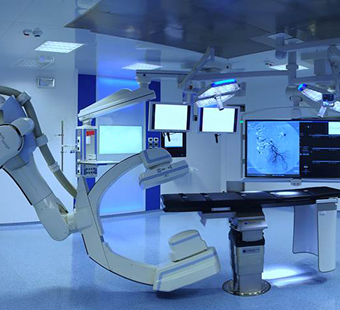
Serendipitously, the medical aesthetics market lends itself to excellent visual marketing. As aesthetics professionals, we have at our immediate disposal abundant, highly effective visual tools that can convince patients to purchase a treatment, or even better, buy multiple treatments or an ongoing series of treatments. The underlying goal of visuals is to provoke emotional responses from patients, turning prospects into conversions. When the staff at your clinic are primed to make use of these visual aids, you’ll see patient bookings and ROI exponentially increase in response.
Why visuals?
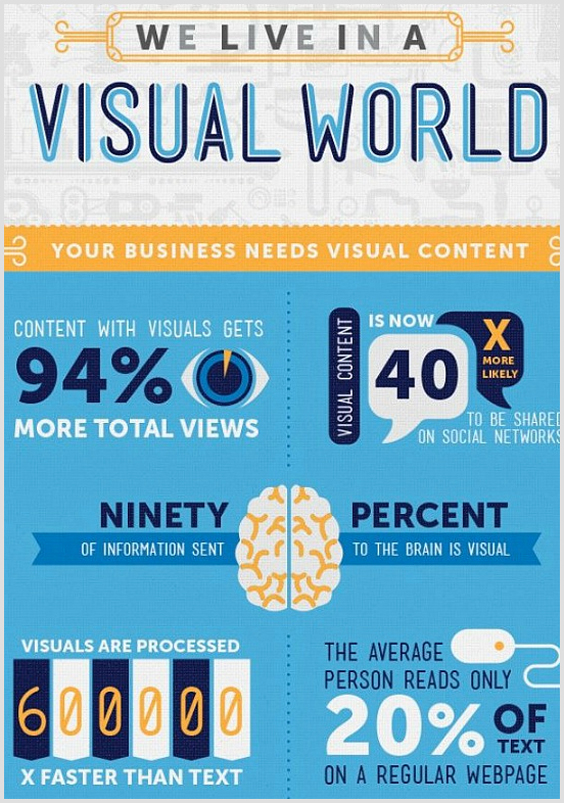
Humans are hardwired to make immediate sense of colors and images as a response to our environment. It’s an evolutionary adaptation and one that still dominates our judgment as we orientate ourselves in the fast-paced, modern world.
When people are saturated with information and overloaded with text, the most forceful way to cut through the noise and rise above competitors is with compelling visuals.
- Consumers tend to only retain between 10-20% of what they read BUT
- When text is accompanied by striking visuals, the absorption rate skyrockets to 65%.
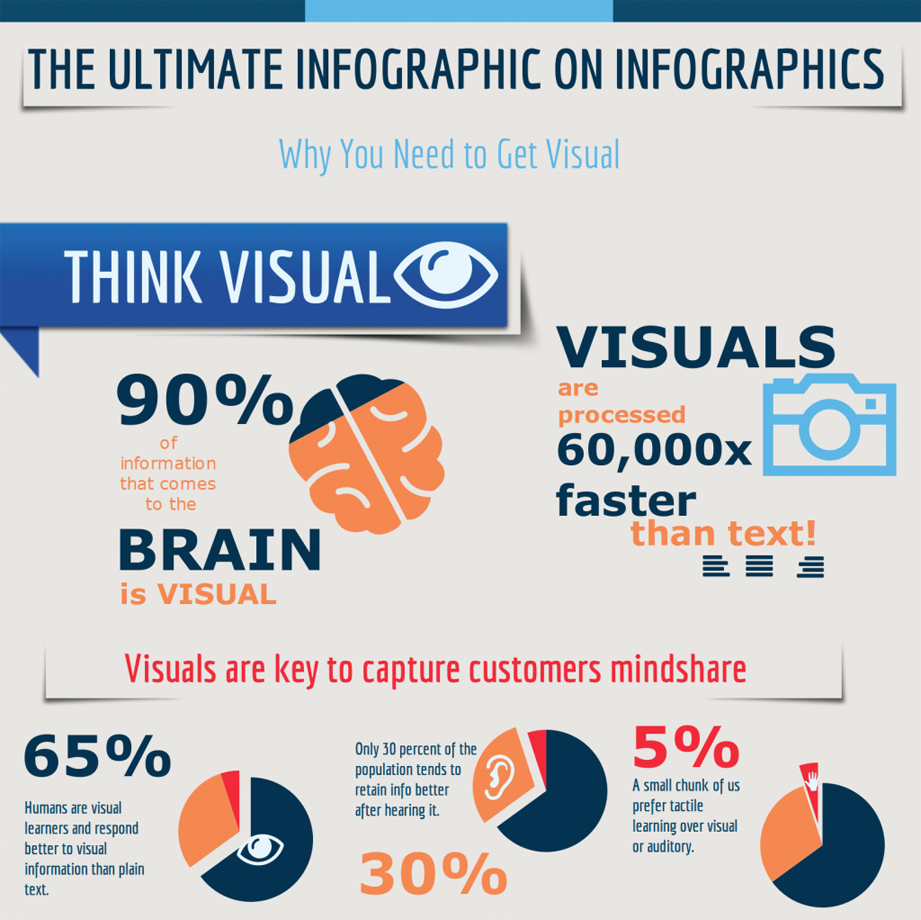
Visuals figure prominently in successful social media campaigns too:
| Tweets with images get 150% more retweets than tweets without images. | Facebook posts with images encourage 2.3 times more engagement than those without. | Social media content generates 94% more views if it contains an image. |
|---|
Also, don’t forget video: video is an incredibly compelling medium for curious consumers.
- 64% of consumers are more willing to purchase a good or service after viewing a video.
Here are some of the hottest insider hacks we’ve compiled on three must-use visual tools and techniques for your aesthetics practice to boost sales. We’ll also provide straightforward methods to educate your staff so they make the most of your visual marketing arsenal too. Read on!
1. Today’s aesthetic audience loves video.
Video is globally loved. Four times as many people would rather watch a video about a product than read about it. According to one survey conducted by Marketing Land, 71% of respondents declared that video conversion rates outperform any other marketing content. Visual marketing is heading increasingly toward video, with one projection forecasting that by 2019, 80% of Internet traffic will be video traffic. Visual food for thought.
Video is uniquely powerful in aesthetics marketing because:
- It can take information that is conceptually complex, and make it immediately accessible and understandable to anyone: a one minute video showing a patient receiving microdermabrasion is infinitely more compelling than a textual analysis of the same technique.
- Video shows your prospects just how skilled and specialized you and your staff are. “While videos are intended to educate, they also show prospects that we are nice people that care about education and are, in fact, well trained ourselves and considered leaders in our specialty,” explains Dr. Roberto Garcia of Contoura Facial Plastic Surgery.
- It can help demystify confusing or intimidating procedures (think invasive surgeries, CoolSculpting, and laser). YouTube has seen a recent boom in the number of live surgeries uploaded, popular among patients who want to understand the process of operations better.
- Video translates exceptionally well to social media. Instagram stories and Facebook posts featuring live videos attract viewers in droves. Facebook users purportedly watch 8 billion videos per day, with the most popular format being live video.
- It evokes an immediate emotional response in people — fascination, suspense, FOMO — instantly connecting the viewer with what is happening on the screen. We can become much more emotionally connected to something we watch, than something we read. People make purchases based on emotion, then justify those purchases later based on logic.
So how can your staff use video to boost sales?
- Animated videos are excellent educational tools. Providers such as Femilift, SculpSure, and various other companies have snappy promotional videos that explain how the technology works if you have no live footage. Staff can draw on these to familiarize patients with the procedure, then answer any questions patients may have.
- If your clinic uses RxPhoto, encourage your staff to show potential patients video content in the RxPhoto Education Center. Content can be easily accessed during consultations on an iPad. If your clinic has live videos, these can also be uploaded into the center and shared.
- If your clinic has some very satisfied regulars, encourage your staff to ask them if they’d feel comfortable having a suitable procedure filmed live in exchange for an incentive, such as a value-add on their next treatment. This material can be loaded into the RxPhoto Education Center and also posted as a Facebook or Instagram story. Vital to a successful video is that the staff member performing the procedure provides a sophisticated step-by-step discussion of the process for the viewer.
Check out this live video from Bay Harbor Perfection Med Spa, demystifying a hydrafacial: only one day old, and already 3,573 views. If a picture is worth 1,000 words, a video is worth more than 3,000 views!
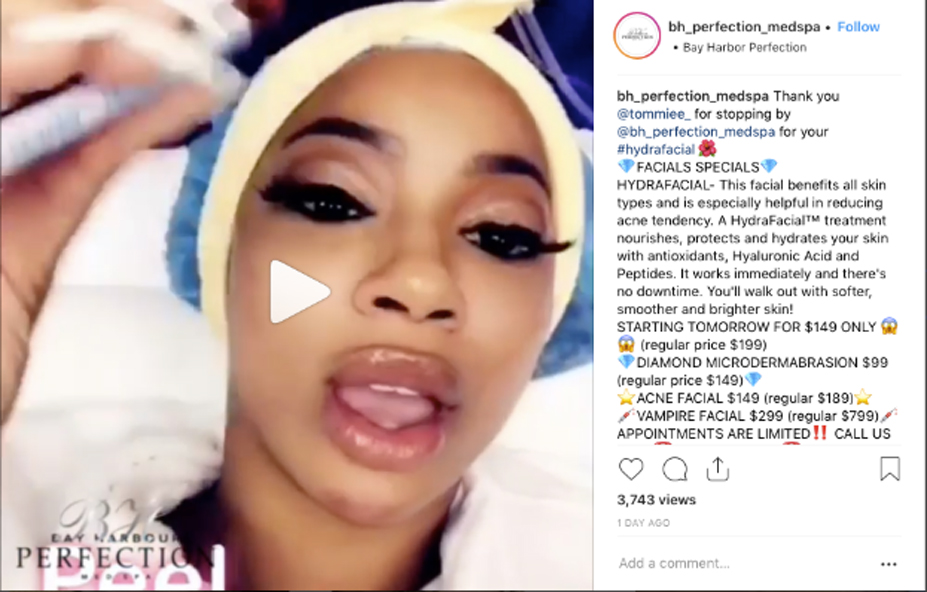
- Customer testimonials are one of the most tried and tested marketing tactics for aesthetic clinics, and video testimonials even more so because they provide visual proof of a procedure. High-quality video promotion is extremely useful in converting customers: an Aberdeen report showed that video users see 27% higher click-through rates and 35% higher web conversion rates.
- Aesthetic consumers feel significantly more confident about purchasing a treatment if there is a visual review or testimonial of the procedure. Educate your staff to ask patients if they’d consider providing a brief video testimonial at the completion of their treatment. These video testimonials can be uploaded to YouTube, or placed on your clinic’s landing page.
Check out these video testimonials from The Medical Spa at Breslow Center housed on YouTube:
2. Before and After Galleries: How to Make Yours Stand Out from the Crowd.
Before and after galleries are a unique visual secret weapon for any aesthetics practice or med spa. Few industries have such a specially customized, emotionally evocative visual aid that can communicate the benefits of a procedure to prospective patients. Before and after galleries are the first thing patients look for when checking out a potential med spa or aesthetic clinic. Google Analytics tells us that before and after pictures are the highest-traffic areas of aesthetics websites.
Every clinic has its own before and after gallery, but very few are effectively using it as a sales tool. When you capture the real potential of your before and after gallery like our clients do, you can look forward to significantly increasing your revenue.
- Use your before and after galleries in the office.
Before and after galleries are indispensable on websites. But they’re also vital in consultations because they allow your staff to upsell at the point of care. Galleries should be present throughout your clinic: in both the waiting room and the exam room. With RxPhoto, your before and after galleries are always at your fingertips, and staff can quickly browse and share them with patients on an iPad.
Why?
1.Your staff can show off their expertise and help patients understand how their skills can meet or exceed their aesthetic goals in ways they hadn’t imagined.
2.Galleries shown during consultations show patients the benefits of multiple treatments, multiple treatment areas, and ongoing treatments. This is a game changer for the patient that thinks they want microdermabrasion but leaves having booked microdermabrasion and a glycolic peel.
- How to up your before and after gallery game
The best before and after galleries must be impeccable in their presentation to effortlessly convince potential clients of the efficacy of a treatment and convert them. What’s more, the most outstanding galleries provoke visual, emotional responses such as admiration, desire, empowerment, aspiration, and even fear in customers, triggering thoughts such as, “If that woman is my age and can look that good following a nonsurgical face-lift, then I can too.”
If you want to extract maximum benefits from this purpose-made aesthetics marketing tool, your before and after gallery MUST:
- Be absolutely consistent: lighting, angles, poses, and background color (ideally blue or grey) should remain identical so the emphasis is on the results, not on deviations between photographs.
- Contain multiple angles of patients. Some procedures, such as dermal filler around the jawline, or Botox for crow’s feet, are most revealing in a profile or ¾ angle shot, rather than portrait format.
- Only use photos taken on one quality device with excellent photographic capabilities.
Take a look at this example of a visually evocative before and after gallery posted by Pierini Esthetic Surgery, and note how the consistency across images makes the improvements pop:
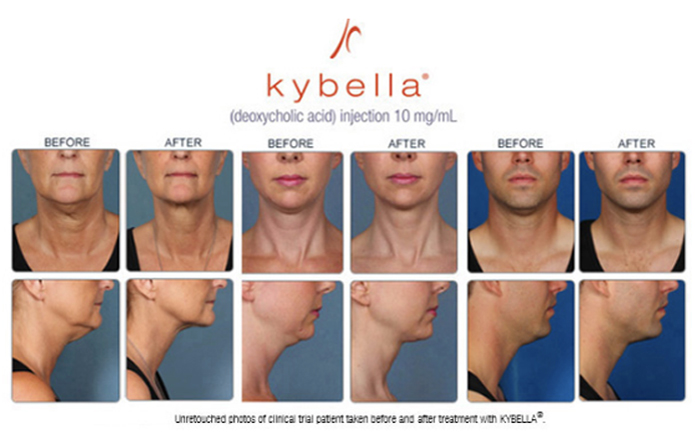
RxPhoto’s photo-ghosting feature means capturing consistent before and after pictures is exceptionally straightforward. The before photo provides a baseline, so the after photograph can be smoothly and flawlessly mapped onto it. When different staff members take pictures of patients, chances are they’ll take the photos from different distances. Photo ghosting solves this issue, ensuring the photo distance is identical each and every time. It’s so easy, even a caveman could do it.

What’s more, RxPhoto allows you to arrange your before and after galleries flexibly according to patient age, gender, ethnicity, and treatment type; so highly specific galleries can be used to target patients of a similar demographic. If you have a new practice and haven’t yet built up a before and after gallery of your own, use the ones provided by RxPhoto, then add your images as you build your clientele.
Patients respond more emotively to photos of individuals similar to themselves, and emotion is instrumental to decision-making: consumers generally act on emotion first, then logically justify purchases later.
“Being able to show before and after photos easily has helped me dramatically improve my consultation conversion rate,” explains Dr. Travis Shaw, M.D., a facial plastic surgeon. Aesthetic customers are looking to purchase a better version of themselves, and before and after visuals help convince them that this is possible.
So how should you educate your staff to use before and after galleries successfully?
- When staff can provide an expert explanation that adds context to before and after images, patients will trust their opinions. Your team should be able to use their influence and credibility to persuade patients of the merits of a given treatment. “We take before and after pictures of every patient when they come in to illustrate what they cannot see themselves in photos. We use this not only as a selling tool but one of education to break the aging process down into components so that our patients will have a better understanding of what we are recommending,” says Dr. Roberto Garcia.
- Encourage your staff members–front of house and experienced injectors–to undergo at least some treatments offered by your clinic and talk to patients about their procedures in an authoritative, experienced manner. Include their before and after images in your galleries, or on social media. Patients who can see the physical evidence of treatment on real people are more likely to have an emotional response and be convinced to undergo the procedure themselves.
- Encourage staff to talk to patients about getting permission to post particularly dramatic before and after transformations on social media including LinkedIn. Even better, follow a patient through their treatment journey, as a case study. Try this strategy:
- Send the patient an email checking if they were happy with the service, or asking them to rate it.
- Ask those who were happy or gave a high rating if they’d be comfortable providing a review or feature in a post that you can share on social media.
- Provide incentives in the form of added value: if they share the posts on social media, the next time they come in, they receive an add-on with their treatment.
A series of before and after shots that tracks patient progress makes for compelling social media viewing.
This post from Bay Harbor Perfection Med Spa provides a striking visual endorsement for the benefits of microblading.
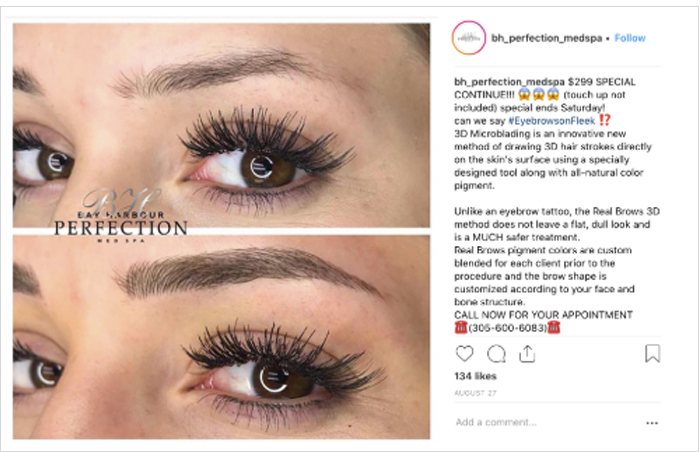
Take a look at this before and after gallery from Tru Glo Medspa following one patient’s progress after a year of Juvéderm Ultra Plus XC dermal filler: subtle change documented visually over a year provides a prospective client with a more authentic understanding of how a dermal filler changes the face.

- Dr. Douglas Steinbrech, a plastic surgeon at Male Plastic Surgery New York, explains that his clinic has an attractive hardcover “coffee table” book with more 100 before and after images inside. “The patients love it as they check it out while they are waiting,” says Dr. Steinbrech. Clinics that use RxPhoto can provide the clinic’s before and after galleries on an iPad in the waiting room for patients to peruse.
3. Use Infographics to Boost Sales.
Infographics represent an underutilized but highly effective visual marketing tool. Infographics are unique because they provide the eyes with something pleasant to see and simple to understand. Consumers respond well to infographics because they give them the rewarding feeling that they can easily comprehend more complex ideas. Search engines love them too, particularly if they are enriched with SEO.
Infographics have been proven to increase a consumer’s willingness to read by 80% because they combine text with colors. Infographics powerfully blend catchy visuals with concise, punchy content to boost marketing campaigns. Most importantly, consumers remember what they’ve read on infographics. So if you have an idea that you want to remain with the consumer, use infographics to do it. When it comes to the bottom line, infographics can boost sales by up to 400%!
Great infographics share the following features:
- Minimal imagery
- Bright, evocative colors–but stick to three colors maximum
- Typography to set a tone
- Text placed in the middle, rather than at the top
Check out this winning example below, educating on the differences between Botox and Dysport.
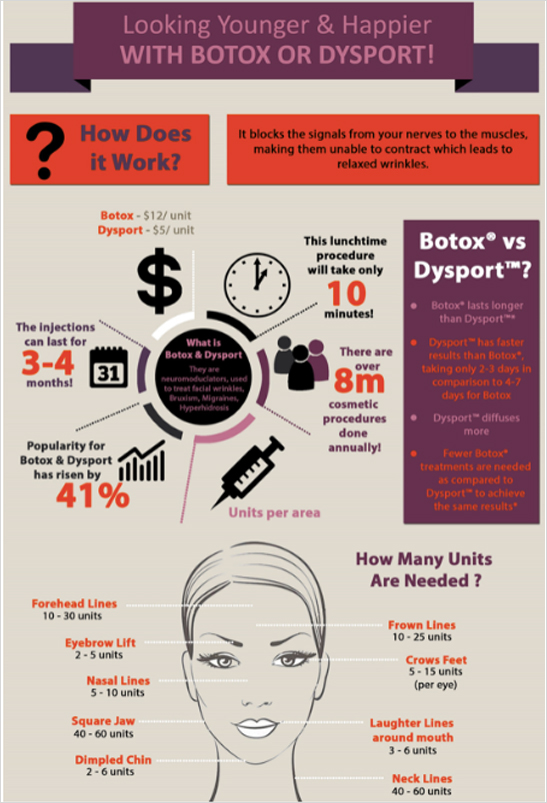
So how can you educate your staff to use infographics? Start by encouraging them to make striking infographics more visible to clients. Social media, blog posts, and waiting room walls are all ideal places to place powerful infographics strategically. For rushed clients wanting immediate access to what they need to know about a treatment, infographics are unparalleled, and at present, underutilized by aesthetic professionals!
Take a look at this breast implant infographic posted by Luna Plastic Surgery on their blog:
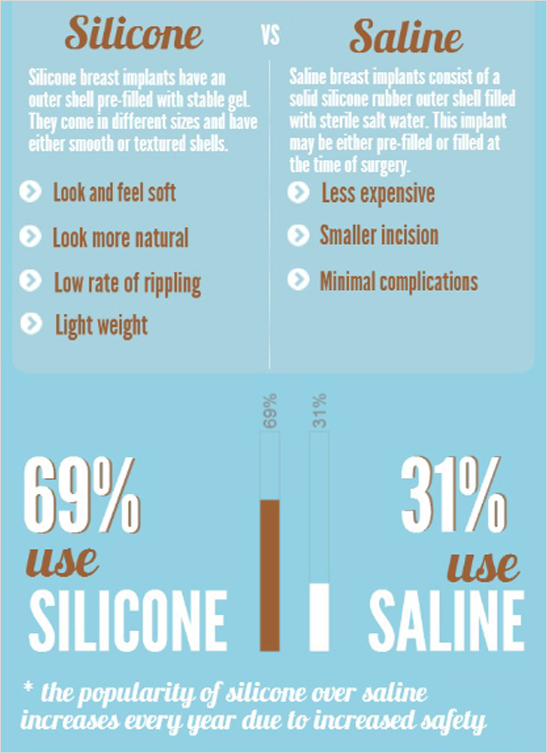
Check out this infographic from the prestigious American Society for Aesthetic Plastic Surgery, providing an overview of surgical lift procedures; the range and depth of information conveyed in this relatively concise infographic are impressive:
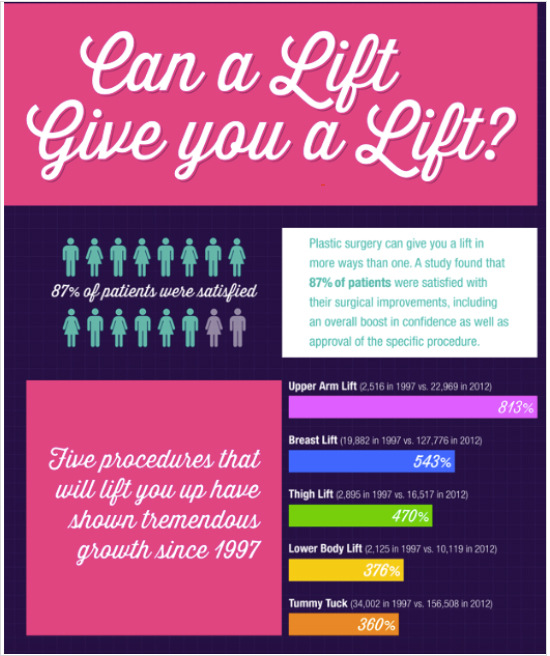
This infographic distinguishes between Botox and dermal fillers, a common tripping point for many uninitiated aesthetic consumers:

The Bottom Line
Aesthetics is the business of making people look good so they feel good, and visuals speak to aesthetics consumers in a way that words cannot. Creative and thoughtful use of visuals in your social media marketing campaigns and throughout your clinic not only captures your clients’ attention, but emotionally impacts them, which is important: people make purchases based on emotion and justify them with logic later.
Are you struggling to take high-quality and consistent before and after photos?
Check out our whitepaper on

Scott Alten
Managing Partner – RxPhoto

How much should you spend on medical photography equipment?Without a doubt, your office needs to take photos of your patients on a daily basis. Whether you’re building a before and…
Ever wonder why you call your clients “patients”? Turns out, the etymology of the word stems from a Latin word that means “enduring, or suffering, without complaint”. And this quiet…
Before and after photos, as well as photos used to document patient procedures are considered PHI (Protected Health Information) by HIPAA, regardless of whether or not clients are using health…
